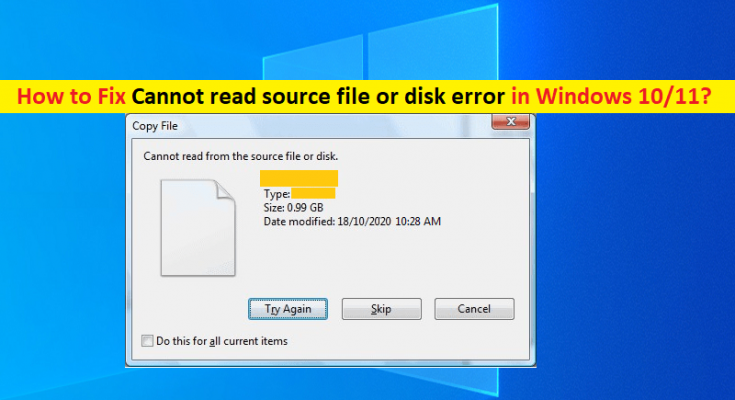What is ‘Cannot read source file or disk error’ in Windows 10/11?
In this article, we are going to discuss on How to fix Cannot read source file or disk error, Cannot read from source file or disk external hard drive in Windows 10/11. You will be guided with easy steps/methods to resolve the issue. Let’s starts the discussion.
‘Cannot read source file or disk’ error: It is common Windows Problem considered disk drive read issue. This error is appeared usually when you try to move files from a drive to another drive on computer, or trying to move/copy the files from your External hard drive, USB or other external drive. This issue indicates you are unable to perform copy operation on your hard drive (internal or external SSD/HDD) when you try to copy the files from the drive.
There could be several reasons behind the issue including the malware or viruses infections in computer, corrupted/outdated hard disk sectors, corruption in system files or registry, or in system image, issue with hard disk (Internal or external HDD/SSD) hardware and its connection, incompatible file systems of hard disk drive, and other Windows issues.
You should make sure SSD/HDD (internal or external) is properly connected to your Windows computer and there is no issue with hard disk drive connections. If hard disk hardware and its connections are good, then you can perform SFC scan, DISM Scan, and CHKDSK scan in your Windows computer in order to corruption in system files, system images, bad hard disk sector and other hard disk drive issue. It is possible to fix the issue with our instructions. Let’s go for the solution.
How to fix Cannot read from source file or disk external hard drive in Windows 10/11?
Method 1: Fix Cannot read source file or disk error with ‘PC Repair Tool’
‘PC Repair Tool’ is easy & quick way to find and fix BSOD errors, DLL errors, EXE errors, problems with programs/applications, malware or viruses issues, system files or registry issues, and other system issues with just few clicks.
Method 2: Restart your computer
Sometimes, this type of issue is occurred due to some temporary issues with your Windows computer. You can just restart your computer in order to fix temporary issues and check if it works for you.
Method 3: Check the filename
Changing the filename is justified when the file was created in one OS, and use its use occurs in another. You may not be able to read from the source file or disk while deleting after using this file on command line. If this is your situation, you should be sure to rename the file properly and restart computer after that and then check if the issue is resolved.
Method 4: Check File Systems type of hard drive

This issue can be occurred due to mismatched file systems. You can check file system type of your hard drive here.
Step 1: Open ‘File Explorer’ in Windows PC and right-click on hard drive with the file you are coping, and select ‘Properties’
Step 2: Under ‘General’ tab, you can check the file system type under ‘File System:’ section
Step 3: Now, repeat same step to check file system of destination hard drive where you are paste the copied file to. If the both file systems are NTFS, move on to next method. If one disk is FAT32, you can’t copy large files onto FAT32, but there have been instances where someone has used a file splitter to break a file into small pieces, and then the file become corrupted on the drive.
Method 5: Run CHKDSK scan

You can run CHKDSK scan in your computer in order to fix bad sector or hard drive corruption, and fix this issue.
Step 1: Type ‘cmd’ in Windows Search Box and press ‘SHIFT + ENTER’ keys on keyboard to open ‘Command Prompt as Administrator’
Step 2: Type ‘chkdsk D: /f’ command and hit ‘Enter’ key to execute. Here, you can change ‘D:’ to hard drive letter that is causing problem.
Step 3: Once executed, restart your computer and check if the issue is resolved.
Method 6: Check File Permissions

This issue can be file occurred due to insufficient permission given to files/folder in hard drive. You can give all necessary permissions in order to fix.
Step 1: Right-click on the file that is causing error, and select ‘Properties’
Step 2: Click ‘Security’ tab, and click ‘Edit’
Step 3: Select ‘Add…’ button in center, type your computer username in box at bottom and select ‘Check Names’, and then click ‘Ok’. This will take you back to previous screen
Step 4: Select your username in top window, check the box next to ‘Full Control’ in bottom box, and click ‘Apply > Ok’ button to save the changes. Once done, check if the issue is resolved.
Conclusion
I am sure this post helped you on How to fix Cannot read source file or disk error, Cannot read from source file or disk external hard drive in Windows 10/11 with several easy steps/methods. You can read & follow our instructions to do so. That’s all. For any suggestions or queries, please write on comment box below.



